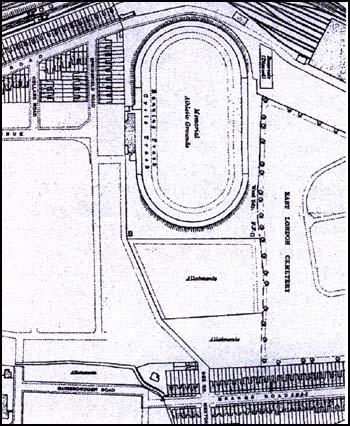Football Stadiums
Football stadiums were initially very primitive. Therefore, the first FA Cup final was held in 1872 at the Kennington Oval, a cricket ground built in 1845. The Oval hosted the final until 1892. The following year, the final between Wolverhampton Wanderers and Everton was held at Fallowfield in Manchester.
Goodison Park was the first purpose built football stadium in England. It cost £8,090, and was officially opened on 24th August 1892. It consisted of two uncovered stands, each to accommodate 4,000 and a covered stand to accommodate 3,000 people. In 1894 it hosted the FA Cup final between Notts County and Bolton Wanderers, a match with an attendance of 37,000.
Women were initially allowed in free at some grounds as it was believed that it would improve the behaviour of make fans. When Preston North End introduced free tickets in April, 1885, over 2,000 women turned up for the game. Free entry for women was so popular that by the late 1890s all the football clubs had discontinued the scheme.
In 1896 Arnold Hills, the chairman of West Ham United, announced that he had purchased land at Canning Town, Hills built what became known as the Memorial Grounds. It cost £20,000 to build and was considered to be one of the best stadiums in the country. Hills claimed it could hold 133,000 spectators and applied to hold an FA Cup Final at the Memorial Grounds. This only allowed 16 inches for each person and the Football Association turned the idea down.

Arnold Hills wanted to hold other sporting events, including cycling and athletics. As well as a football arena, it also had a cinder running track, tennis courts and an outdoor swimming pool. According to one report, the 100 feet (30.4m) long pool was the largest in England. The Memorial Grounds was opened in June, 1897. Hills made a speech where he pointed out that it had "the largest cycle track in London where they would hold such monster meetings that the attention of the Metropolis would be called to the Thames Ironworks".
The site had been chosen because it was planned to build Manor Road railway station close to the stadium. Unfortunately the project was delayed and it was not finished until four years later. This meant that attendances at the ground were much lower than expected.
Season tickets for the 1897-98 were fixed at 5 shillings (25p). Tickets for individual matches cost 4d. However, attendances at games were very disappointing. Only 200 people saw the first game against Northfleet. This is not surprising when you compare this with the price of other forms of entertainment. It usually cost only 3d. to visit the musical hall or the cinema. It has to be remembered that at this time skilled tradesmen usually received less than £2 a week.
As Dave Russell points out in Football and the English: A Social History of Association Football in England (1997): "in terms of social class, crowds at Football League matches were predominantly drawn from the skilled working and lower-middle classes... Social groups below that level were largely excluded by the admission price." Russell adds "the Football League, quite possibly in a deliberate attempt to limit the access of poorer (and this supposedly "rowdier") supporters, raised the minimum adult male admission price to 6d".
In the 1899-1900 West Ham United was promoted to the top division of the Southern League and it was decided to increase season ticket prices. It was now 10s. 6d (52.5p) for the grandstand and 7s. 6d. (37.5p) for the rest of the ground. The first home game was against Chatham. The attendance of 1,000 was lower than most games the previous season and was probably a reaction to the price rise. However, for a FA Cup game against local rivals, Millwall, an estimated 13,000 people turned up to see the game.
The most important figure in the design of football stadiums was Archibald Leitch. In 1899 he was commissioned to build Ibrox Park, the new home ground of Rangers. The new stadium comprised large wooden terraces and a stand accommodating some 4,500 spectators. However, people began to question Leitch's safety features when on 5th April, 1902, when 25 people were killed and 517 injured as part of the west terracing collapsed during the annual international game with England.
Despite this disaster Archibald Leitch was commissioned to build other football grounds. In 1909 John Henry Davies, the chairman of Manchester United, decided to loan the club £60,000 in order that they could build a new stadium with an 80,000 capacity. The Old Trafford ground featured seating in the south stand under cover, while the remaining three stands were left as terraces and uncovered. When it was completed the stadium had the largest grandstand in the Football League. It also had a gymnasium, massage room, plunge baths, bars, lifts and tearooms.
The Empire Stadium at Wembley was built by Robert McAlpine for the British Empire Exhibition of 1923, at a cost of £750,000. It was originally intended intended to be demolished at the end of the Exhibition. However, it was later decided to keep the building to host football matches. The first match at Wembley, the 1923 FA Cup Final between West Ham United and Bolton Wanderers, took place only four days after the stadium was completed.
The Empire Stadium had a capacity of 125,000 and so the Football Association did not consider making it an all-ticket match. After all, both teams only had an average attendance of around 20,000 for league games. However, it was rare for a club from London to make the final of the FA Cup and supporters of other clubs in the city saw it as a North v South game. It is estimated that 300,000 people attempted to get into the ground. Over a thousand people were injured getting in and out of the stadium.
